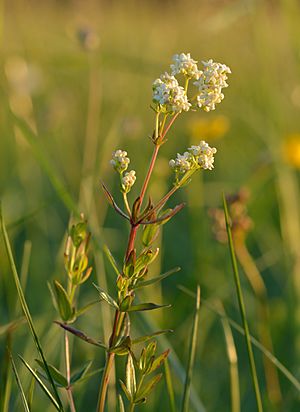Northern bedstraw facts for kids
Quick facts for kids Northern bedstraw |
|
|---|---|
 |
|
| Scientific classification | |
| Genus: |
Galium
|
| Species: |
boreale
|
Galium boreale, also called northern bedstraw, is a plant that belongs to the Rubiaceae family. You can find it all over the cool and cold regions of Europe, Asia, and North America. This includes most of Canada and the northern United States.
Contents
What Does It Look Like?
Northern bedstraw is a perennial plant. This means it lives for more than two years. Its leaves and stems die back to the ground each winter, but the roots stay alive. New plants can grow from underground stems called rhizomes. These rhizomes help the plant spread and form new groups of plants around the original one.
The stems of the northern bedstraw are usually square-shaped and do not have branches. They can grow to be about 20 to 50 centimeters (8 to 20 inches) tall. Its leaves are attached right to the stem in groups of four. They are spaced evenly, like the spokes of a wheel. The leaves are longer than they are wide and have three clear veins.
Small white flowers grow in clusters at the top of the stem. These clusters are called panicles and can look quite showy. Each flower has four pointed parts that fold back. Inside, there are parts for making seeds, like the stamens and pistil. These flowers have a light, pleasant smell and do not have sepals. After the flowers, dark fruits form in pairs. These fruits might have short hairs on them.
Where Does It Grow?
Northern bedstraw likes sunny places with soil that can be dry or a little moist. You can find it in forests, areas with shrubs, or grasslands. It naturally grows in the subarctic and temperate parts of the Northern Hemisphere. This means it grows in places that are cool or have mild climates. In some places, like the states of Maryland and Massachusetts, it is listed as an endangered plant.
Who Eats It?
Northern bedstraw is an important food source for the young forms (larvae) of several moths. These include the Elephant hawk moth (Deilephila elpenor), D. porcellus, Epirrhoe galiata, Eupithecia subumbrata, and Gandaritis pyraliata.
How It Got Its Name
The plant Galium boreale was first described by a famous scientist named Carl Linnaeus in 1753. He studied the plants found in Europe. Later, in 1818, another plant called Galium septentrionale was described from North America. Scientists later found out that G. septentrionale was actually the same plant as G. boreale. So, G. septentrionale became a synonym (another name for the same thing) of G. boreale in 2003.
The group of plants that northern bedstraw belongs to is called Galium. This group is part of the larger Rubiaceae plant family.
Can We Use It?
Northern bedstraw can be eaten! It has a sweet smell and taste. You can eat it as a wild salad green. Some types of Galium plants have small hooks on their stems, like Galium aparine. Northern bedstraw does not have these hooks, so it might not be as tasty as the hooked types. However, it's still a useful plant to know about if you ever need to find food in the wild.
See also
 In Spanish: Galium boreale para niños
In Spanish: Galium boreale para niños

